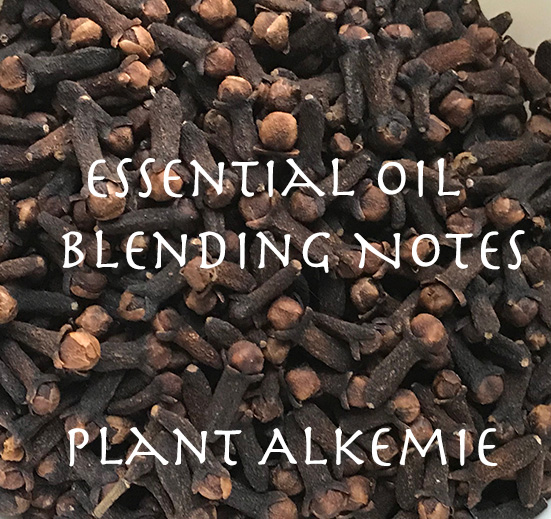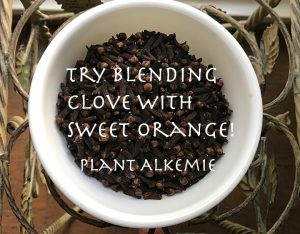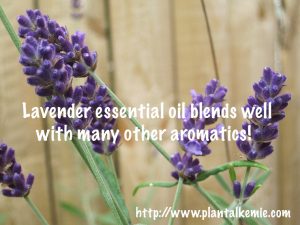Aromatherapy And Natural Perfumery Blending Notes

One of the things I enjoy the most is making aromatherapy scent blends and natural perfumes! Blending is an art, and it can be confusing to know which aromatics blend well with what. Here are some of my notes on which essential oils blend well together. These suggestions are based on my personal experiences with making aromatherapy scent blends and all natural perfumes. Please note, this information is based only on aroma. Even if you are blending only for fragrance, you still need to take into account safety considerations when using essential oils and other aromatics. So be sure to research essential oils well before use to make sure that they are safe for you and your particular needs!
Each essential oil has a few different notes, so essential oils may be listed in a few different categories below.
These are not exhaustive lists. I have listed only a few aromatics for each essential oil. They definitely blend well with other aromatics! I recommended some of my favorites. Experiment and find out what you love to blend these essential oils with!
Note: There are several different types of aromatics. Many of the listed aromatics are available as essential oils. While others are available as absolutes, CO2 extracts, or oleoresins. Some aromatics are available as a few different types. For example, different rose species are available as essential oils, absolutes, and CO2 extracts. I have listed a few different types of aromatics in my notes.
Like other citruses, Bergamot essential oil (Citrus bergamia) blends well with a lot of different aromatics! Bergamot essential oil is phototoxic. But there is a non-phototoxic version, which is labeled as bergamot FCF essential oil. I highly recommend blending bergamot with other citrus peel and leaf oils (mandarin, lemon, grapefruit, sweet orange, lime). It also blends beautifully with the following notes: herbaceous (thyme, rosemary), woods (West Australian sandalwood), gourmand (the vanilla aromatics, cocoa absolute or CO2 extract), florals (neroli, lavender, the ylang ylang essential oils, the jasmine absolutes), roots (vetiver), greens (patchouli, clary sage), the resins (such as the frankincenses), and spices (cardamom, black pepper).
Carrot seed essential oil (Daucus carota) can be difficult to blend with. It has a distinct strong scent, which is earthy, woody, and a bit spicy. It blends well with citrus peels (sweet orange, lemon), florals (geranium, lavender), resins (the frankincenses), green (cypress), spicy (cardamom), and woody notes (the cedarwoods).
Clove essential oil (Eugenia caryophyllata) blends well with other spices (cardamom, ginger), citrus peels and leaves (sweet orange, tangerine, clementine), the florals (the jasmine absolutes, lavender, the ylang ylang essential oils), herbaceous (peppermint, rosemary), and the vanilla aromatics (vanilla oleoresin, absolute, CO2 extract, tincture/extract, glycerite, and infused oil).
Helichrysum essential oil can be hard to blend with. It is a honeyed, spicy, sweet, complex scent with a floral back note. There are a few different helichrysum species that we use in aromatherapy and natural perfumery. These blending notes are for Helichrysum italicum. Helichrysum blends well with citrus peels and petitgrains/leaves (bitter orange, sweet orange, mandarin), floral notes (the rose aromatics, the jasmine absolutes, high altitude lavender, geranium), herbaceous scents (roman chamomile, patchouli, lavender, clary sage, geranium), and spicy fragrances (clove).
Lavender essential oil (Lavandula angustifolia) blends well with almost everything! Some recommendations are citrus peels (grapefruit, lemon, sweet orange, mandarin), petitgrains (bitter orange, combava, mandarin), gourmand (the vanilla aromatics, cocoa absolute and CO2 extract), green (patchouli, clary sage), herbaceous (rosemary, thyme), woody (West Australian sandalwood, the cedarwoods), spicy (clove, cinnamon leaf), coniferous (balsam fir, black spruce), and florals (the rose aromatics, the jasmine absolutes, neroli).
Patchouli essential oil (Pogostemon cablin) is one of those scents that people either really love or they dislike! If you don’t like the scent of patchouli, set it aside and let it age for a few to several years. Patchouli’s scent gets better with age and aged patchouli smells amazing! Patchouli blends well many other aromatics. Some of my favorite aromatics to blend patchouli with are the vanilla aromatics, citrus peels and leaves (clementine, sweet orange, lemon, yuzu, lime), roots (vetiver), greens (clary sage, the firs), woods (the cedarwoods, West Australian sandalwood), resins (myrrh, the frankincenses), florals (the rose aromatics, the jasmine absolutes, lavender, the ylang ylang essential oils), and spicy notes (black pepper, clove).
I hope you’ve enjoyed my blending notes! Are there other aromatics that you would like to see in a future blending note article? If yes, please leave a comment!
For more information or if you have questions about aromatherapy, herbalism, formulation, perfumery, eco living, and natural skin and hair care, please join Plant Alkemie’s Facebook group and Plant Alkemie’s Facebook fan page. And be sure to check out more articles on Plant Alkemie’s website: https://www.plantalkemie.com.



Yes, more please!
Hi Chris, I am so glad you enjoyed the article! I will definitely write more blending note articles in the future! Right now I am working on several other articles, so stay tuned 🙂 Have a nice day!
Dear Li,
Thanks so much for another inspiring article. It was really fun for me to see what your favorite aromatics to blend with are, as well as getting the chance to hear you describe some of the ways that you most enjoy blending with them! As a side note, I found it very helpful that you provided insights as to how to work with essential oils which are commonly thought of as difficult to blend with, while at the same time… featuring essential oils which are considered more well rounded, and therefore, easier to blend with in general. This way beginning blenders will have some aromatically low-risk options to play with when materials or time are scarce.
Speaking of time, if you have the time or interest to answer questions on your blog, I have a two:
1. How would you characterize the aromatic, therapeutic, and fixative differences between complete bergamot versus FCF bergamot? … I have the same question for other citrus essential oils which are potentially phototoxic, versus their FCF versions.
2. Do you have any advice on where to buy or how to work with folded citrus essential oils? (Please disregard if this is a topic for an upcoming article.) 🙂
If you will not be writing an article on this, I would like to know why one would use a folded citrus aromatic, versus a FCF one.
Have a wonderful day! You’re the greatest!
Hi Angie, thanks for your comments! The aroma for bergamot is a bit different between regular and FCF, but most consider the therapeutics to be similar. It’s a top note.
I often bought the folded citruses through coops or wholesale businesses (I first tried them many years ago, like maybe 12-13 years ago?). Folded orange essential oil is probably the most common one you will find at the retail level. You can check many soap vendors too. The folded citrus are used in soap, the food industry, and in advanced aromatic medicine.
Good Morning Li,
I’ve only smelled FCF Bergamot from one company, and it seemed more tart and less dimensional than the one unaltered Bergamot I have. Additionally, It seemed as though the FCF bergamot vanished much more quickly than my unaltered bergamot when diffusing.
This is why I asked. However, there is probably no getting around that fact that I need to continue trying out more FCF and unaltered bergamots from various companies who supply batch specific GC/MS’s so I can gain experiential knowledge. Based on what you shared in your response, it could be that the differences that I’ve experienced thus far, may have been more about where my particular Bergamot and FCF Bergamot’s were harvested, processed, and/or possible adulteration.
PS: You are right, I should have used the word volatile instead of fixative in my question earlier 🙂
Thank you for sharing where to find a good folded orange privately, as well as some appropriate uses for it.
Have a wonderful day!
Angie
Hi Angie, yes bergamot FCF doesn’t smell as good as regular bergamot. But you can find an amazing smelling bergamot FCF if you look around.
Cheers,
Li